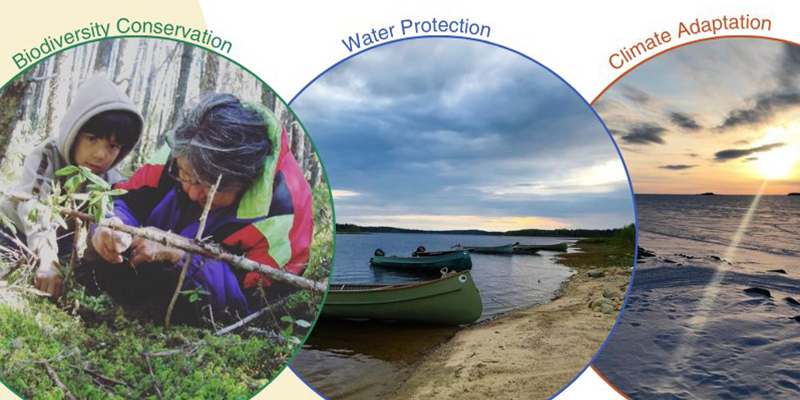On September 23, the Cree Nation Government and Quebec announced a $6 million agreement over four years (2025-2028) to support Indigenous leadership in biodiversity conservation. Cree-led environmental projects will be supported by the newly launched Eeyou EcoFund. Quebec’s 2030 Nature Plan, in partnership with First Nations and the Inuit, aims to protect 30% of the province. When the nearly billion-dollar strategy for achieving this vision was announced a year ago, about 17% of Quebec was protected. “This partnership will enhance our communities’ capacity in conservation, advance our priorities and ensures that Cree knowledge and leadership continue to guide the protection of our lands and waters,” said Nadia Saganash, the CNG’s director of Quebec-Indigenous relations. Cree communities and organizations are encouraged to work on ecosystem restoration, habitat protection, conservation planning, promotion of traditional knowledge and environmental resilience. The goal is to slow climate change and promote responsible resource management. “There were a lot of interesting projects proposed before this was officially launched,” said Olivier Kölmel, the CNG’s manager of eco-investments. “I’m expecting an influx of diverse projects of all types – the initiatives have to come from the ground up.” Financed by Quebec’s Environment Ministry, the Eeyou EcoFund’s initial focus is on biodiversity conservation, with forthcoming funding for water protection and climate change adaptation. Acceptable projects may include anything from land-based restoration and monitoring to community-based workshops and education programs. Some examples promoting biodiversity are wetland recovery, shoreline planting, wildlife corridors, invasive species control, eco-tourism trails, water sensors, weather stations and land-use maps. “We’ve had calls about intergenerational activities where Elders would take youth out on the land and share the knowledge and culture,” Kölmel told the Nation. “The Cree way of life is intertwined with stewarding the land, these practices that have been central to Cree survival for millennia.” Potential projects include youth land camps and environmental awareness workshops that promote community engagement. The EcoFund will be co-managed by a committee of Cree Nation representatives and one observer from Quebec. A separate steering committee will be split between CNG and Quebec representatives. Kölmel cited a study published this summer on James Bay’s eelgrass loss as an example of what the EcoFund could support. With La Grande and other rivers bringing in sediment and contributing to riverbank erosion, the cloudy water was found to block sunlight required for healthy eelgrass, an important food source for migrating geese. The Cree Nation’s development of Indigenous Protected Conservation Areas (IPCAs) is perhaps a higher priority under the fund’s mandate. Quebec’s conservation goals are designed to meet global targets under the Kunming-Montreal Global Biodiversity Framework adopted in 2022. Last December, Cree and Quebec governments announced the creation of Nibiischii National Park in the Mistissini area, the province’s first national park to be operated by a Cree community. Around the same time, the CNG launched the first of four phases of community consultations to expand its protected areas, which should be completed in 2026. “The first phase was information sessions that wrapped up early spring,” said Chantal Otter Tétreault, the CNG’s protected areas coordinator. “We just finished the second phase, which is data collection workshops within all the communities. Next phase is to go back to communities with these proposals and see what mechanism fits best these needs.” Working with Nature Conservancy of Canada to refine previously selected boundaries and propose new areas, the CNG is collecting information from land users to develop conservation initiatives. It hopes to expand a land keepers’ program for monitoring and management of these areas. “They’re still negotiating with Quebec for more long-term funding,” said Tétreault. “Land keepers are safeguarding the territory and educating non-Natives and Natives on how to carry out activities on the land. We’re hoping to expand the land keepers to other communities and give them more responsibilities in protected areas.” As the province works towards Plan Nord’s even more ambitious target of 50% conservation by 2050, the CNG is exploring mechanisms like the Aboriginal-Led Protected Areas legislation. Meanwhile, the proposed Wiinipaakw National Marine Conservation Area would extend these protections to the offshore waters of eastern James Bay. “There is that opportunity with the increase of the protected area network to increase eco-tourism and economic spin-offs for the green and blue economy,” Tétreault asserted. “We’ll continue to work with the communities to protect what we can with whatever means possible.”
Friday, 21 Nov 2025
Canada – The Illusion
Search
Have an existing account?
Sign In
© 2022 Foxiz News Network. Ruby Design Company. All Rights Reserved.
You May also Like
- More News:
- history
- Standing Bear Network
- John Gonzalez
- ᐊᔭᐦᑊ ayahp — It happened
- Creation
- Beneath the Water
- Olympic gold medal
- Jim Thorpe
- type O blood
- the bringer of life
- Raven
- Wás’agi
- NoiseCat
- 'Sugarcane'
- The rivers still sing
- ᑲᓂᐸᐏᐟ ᒪᐢᑿ
- ᐅᑳᐤ okâw — We remember
- ᐊᓂᓈᐯᐃᐧᐣ aninâpêwin — Truth
- This is what it means to be human.
- Nokoma












